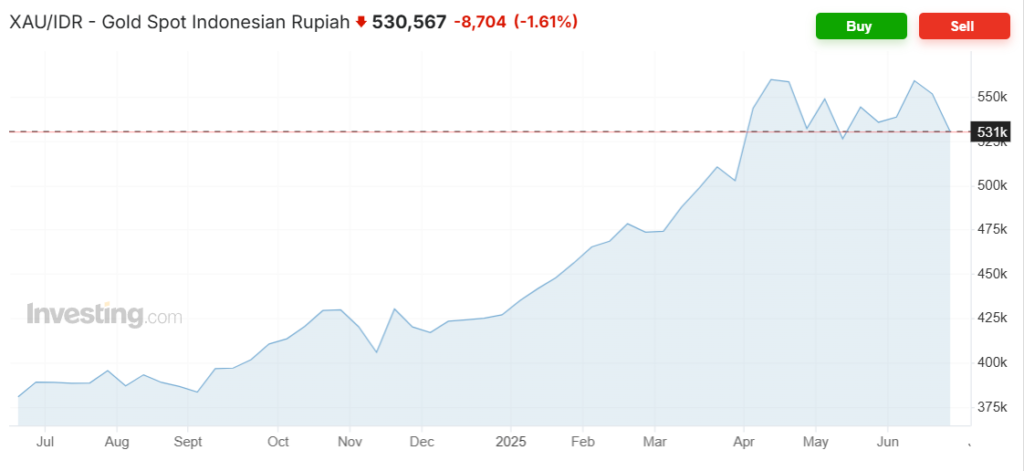Why More Indonesians Are Turning to Gold-Rupiah Trading in a Volatile Economy
October 5, 2024

Rising Inflation Keeps Gold in Focus for Indonesian Investors
As inflation persists across global markets, gold continues to play its traditional role as a hedge against currency erosion. In Indonesia, concerns about the weakening Rupiah and the rising cost of living have pushed retail traders toward alternative assets. The XAU/IDR pair — which reflects the value of gold in Indonesian Rupiah — is increasingly being used not only by forex traders but also by those seeking a financial safe zone. This dynamic shift is influencing how the typical XAU IDR trading strategy is framed: more hedging, less speculation.
Central Bank Signals and Policy Shifts Are Becoming Trade Catalysts

Source: TradingEconomics
With Bank Indonesia closely watching inflation while the U.S. Federal Reserve balances between rate hikes and pauses, the gold-Rupiah pair is reacting quickly to central bank cues. This sensitivity has led many Indonesian traders to start positioning ahead of scheduled monetary policy statements. It’s also shifted the trend from technical-only strategies to mixed approaches that include economic forecasting. In short, the XAU IDR trading strategy is becoming increasingly macro-driven — and news timing is now as important as technical signals.
Shorter Timeframes and Tactical Scalping Are on the Rise

Source: Investing.com
While some traders hold XAU/IDR positions longer to ride broader trends, there’s a noticeable increase in short-term trading behaviors. Scalping strategies during the London–New York overlap (3 PM–1 AM WIB) are growing, especially when news flow is dense. This change is fueled by increased volatility and the availability of more responsive mobile trading tools. The average XAU IDR trading strategy now includes stop-loss automation, time-specific entry windows, and quick-exit rules designed for high-momentum moves.
A Growing Divide Between Conservative Gold Savers and Active FX Traders
Interestingly, not all Indonesians approach XAU/IDR with the same intent. Some use it as part of a passive gold savings plan (invest emas), reacting slowly to macro changes and treating gold as a store of value. Others — particularly younger, app-savvy traders — treat it like any other volatile forex pair. This has created a split: long-hold versus fast-trade. Platforms are adapting, offering both micro-investment gold plans and full trading suites. The modern strategy must now consider user intent more than ever before.
XAU IDR Trading Strategy: Chart-Based Strategies Still Dominate, But With Local Modifications
Most Indonesian traders still rely on core tools like support/resistance, moving averages, and candlestick patterns. However, chart behavior for XAU/IDR sometimes differs from global gold benchmarks (like XAU/USD) due to IDR-specific drivers. As a result, traders are modifying their strategies — using regional overlays, adjusting trade timing, or analyzing cross-pairs. A nuanced XAU IDR trading strategy in today’s market doesn’t just mirror gold — it adjusts for local economic temperature.
Looking Ahead: XAU IDR Trading Strategy- Flexibility and Risk Awareness Define the Winning Edge

As 2025 progresses, it’s clear that volatility will remain a key theme — and the gold-Rupiah pair will likely keep attracting attention. Traders who can remain flexible, adapt to news catalysts, and respect the dual nature of this pair (global commodity vs. local currency) will have a clearer path forward. The most effective XAU IDR trading strategy is no longer about copying patterns — it’s about adapting frameworks based on changing behavior and risk conditions.
Conclusion: XAU IDR Trading Strategy- A Changing Strategy for a Changing Pair

The XAU IDR trading strategy in Indonesia has matured. From passive gold accumulation to precision-based trading, the landscape is more dynamic than ever. As gold continues to shift in response to global uncertainty, and as the Rupiah reacts to domestic pressures, traders are being forced to think in layers. One thing is certain: success with XAU/IDR requires more than just price prediction — it demands pattern recognition, timing sensitivity, and contextual judgment.

